Lakeshore Railroad celebrates 50th anniversary
Posted by Chris Graham on 5th December 2022
David Reed reports on the fantastic 50th anniversary celebrations that took place at the Lakeshore Railroad in South Shields back in July.
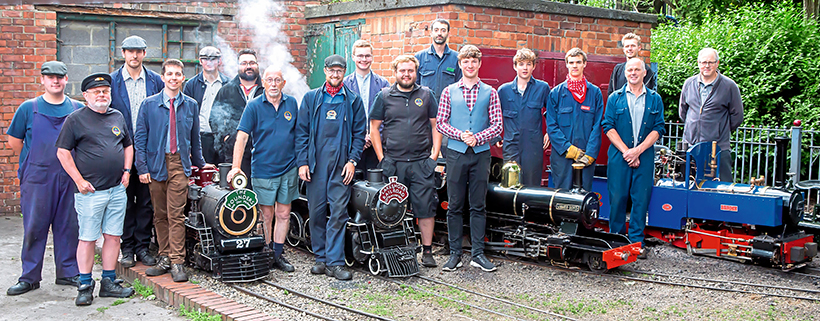
The staff at the Lakeshore Railroad in South Shields face the camera during their 50th Anniversary celebrations.
Many eyes in the miniature railway world were focussed on South Shields over the weekend of July 2nd-3rd, for the 50th anniversary of the Lakeshore Railroad. Early morning saw a busy scene in the shed area, where a number of steam locomotives were being readied for a busy day of work. It was an historic weekend all round, with the railway celebrating its 50th anniversary, a milestone that could not be ignored.
Now a firm fixture in the town’s South Marine Park, the railway can trace its history back to the late 1960s, when Jack Wakefield of Hetton-le-Hole and Don Proudlock of Wingate, Co. Durham, bought the partly-built locomotive Mountaineer from WL Jennings of Templecombe, and completed its restoration.
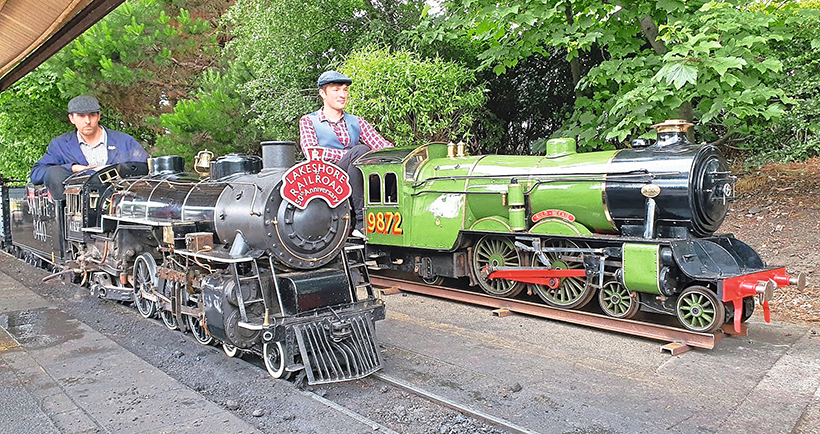
Mountaineer and Auld Reekie together again. The two engines stand side by side in the station area. (Pic: Lakeshore Railroad)
This locomotive actually owes its existence to another Jennings engine, namely 4-4-2 Auld Reekie, that was making a guest appearance at South Shields. Built in 1935 to 9½in gauge, it was initially intended to be a true steam locomotive, but a lack of funds for the boiler put paid to that idea. Although the engine was completed with a steam outline, it was actually fitted with an Austin 7 petrol engine in the tender, with a jack shaft transferring drive to the locomotive’s wheels.
The system worked, and Auld Reekie went on to run briefly on railways at Barry Island and Weymouth before being sold to finance the construction of Mountaineer. As for Auld Reekie itself, the engine was sold in 1936 to Matthew Kerr Snr, and re-gauged to 10¼in for his miniature railway at Arbroath in Scotland.
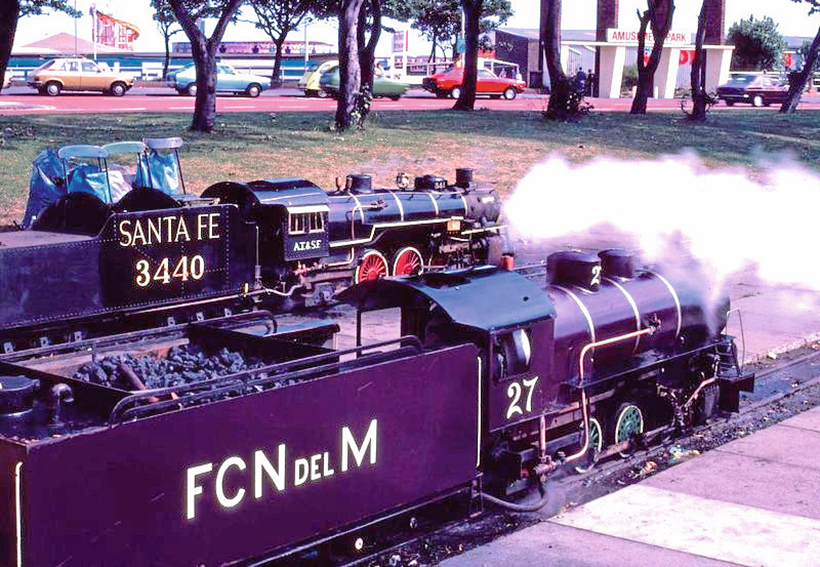
The cars in the background show the age of this shot of the two engines taken during the early days of the railway in South Shields. (Pic: Lakeshore Railroad)
Mountaineer was, like its predecessor, built as an Atlantic despite being inspired by the AT&SF 3400 Class Pacific locomotives. Work on the engine paused during the war years as Jennings served as a landing craft driver but, when construction re-commenced, history started to repeat itself. Just like its sister locomotive, Auld Reekie, Mountaineer’s construction was halted due to lack of funds for a boiler. There was really only one answer, and that was to put Mountaineer up for sale.
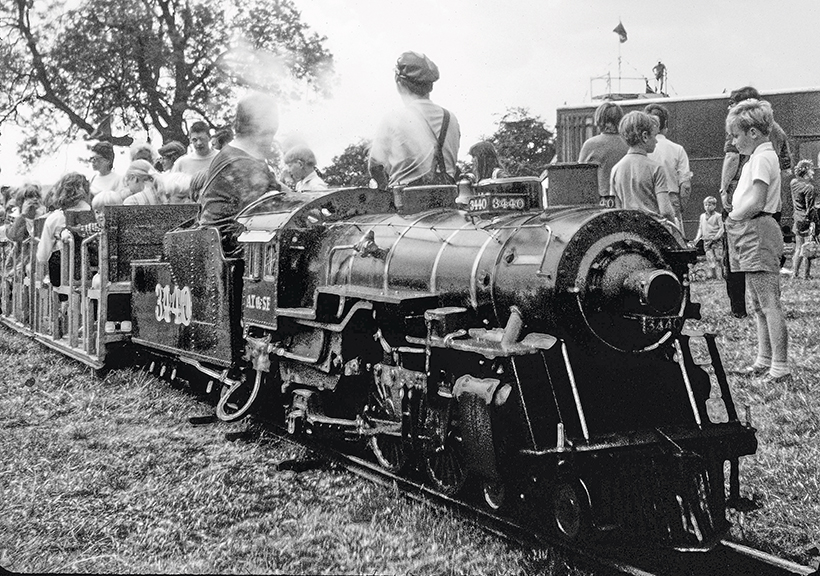
Seen at Masham Steam Rally in 1971, Mountaineer is on its portable track before the site at South Shields became available. (Pic: Lakeshore Railroad)
Luckily a new home was found for the loco, with two of the Lakeshore Railway’s three founding members, Jack Wakefield and Don Proudlock buying Mountaineer in 1966, and finishing the project as a true steam locomotive. The process took two years, but the next problem was where to run the engine? The answer was to take the locomotive to traction engine rallies where it would provide rides for visitors on a length of track. It was a popular attraction, with rallies being attended all over the country, but the time and cost of travelling led to the need for a permanent location to be found, and various options in the north-east were investigated.
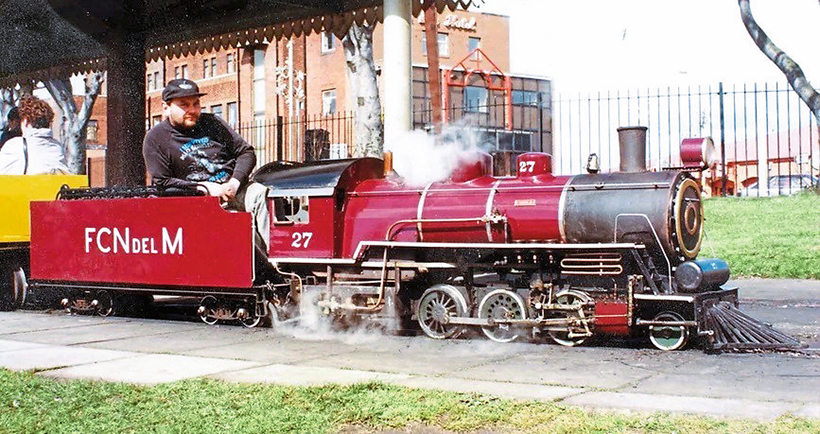
There is no date for this photo of Adiela on the railway, but it was probably taken in the mid-to-late 1970s.
(Pic: Lakeshore Railroad)
Unfortunately, at the time, nowhere seemed to be suitable then, in 1971, the then entertainments manager for South Shields approached Jack and Don with a view to establishing a railway in South Marine Park, the site it now occupies. Construction commenced in September 1971, and continued throughout the autumn and winter periods during daylight hours, with the team then retreating to Jack’s workshop where the rails and sleepers were prepared for track-laying.
Jack and Don were joined by Mike Henderson, who had helped in the operation of the portable track at rallies and, by Easter 1972, about a third of the track had been laid. The railway duly opened over the holiday weekend, running out-and-back from a temporary station with the full circuit being completed in June of that year.
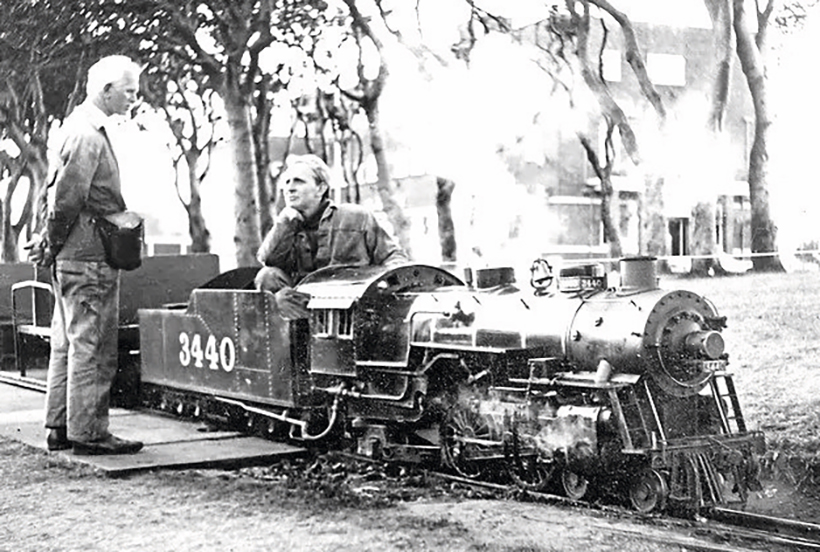
Jack Wakefield and Don Proudlock are seen with Mountaineer, back in 1972. (Pic: Lakeshore Railroad)
By late 1975, Jack Wakefield had decided he wished to retire while Don and Mike realised that a second locomotive on the railway would be extremely beneficial. They found No. 27; a locomotive that would later be called Adiela. This engine had been built by Bell & Burgoyne to run on the latter’s Crowthorne Farm Railway in Berkshire, and was unrecognisable from the loco it is today. It was originally built as an 0-8-0 plus tender locomotive at 2.7in scale and numbered ‘1003’.
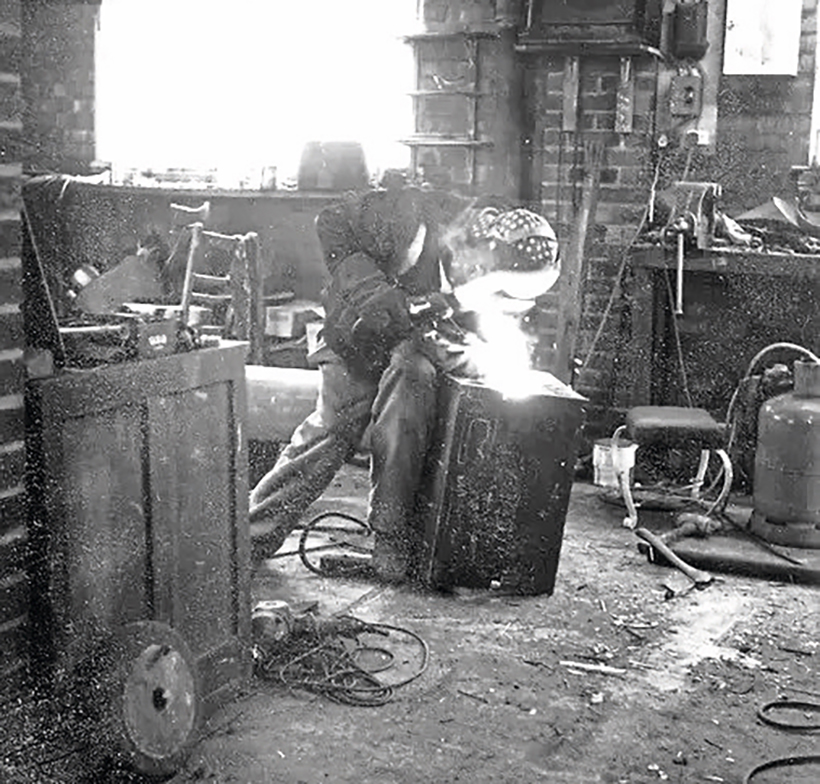
Jim Goldsworthy is seen welding Adiela’s firebox in 1975/’76. (Pic: Lakeshore Railroad)
Upon Vere Burgoyne’s death aged 43, in 1943, the engine was sold to Ron Hammet who operated a number of miniature railways in and around London, including the East Ham Railway where the engine initially ran. Now named Austerity, the loco ran for a very short time at Danson Park at Bexley, in Kent, which was another of Hammet’s lines but, unfortunately, wasn’t up to the job for a couple of reasons. It wasn’t long before an extra pair of wheels were added in front of the driving wheels, due to the locomotive’s tendency to derail, (making it a 2-8-0 plus tender locomotive and giving it a slightly more British look), while its riveted boiler resulted in steaming problems.
The engine was initially used as a spare loco, and then fell into disuse and, over time, was dismantled, with parts being used on other locos. Eventually, its chassis was all that remained, even the tender was used with another loco, and the engine looked destined for the scrapyard.
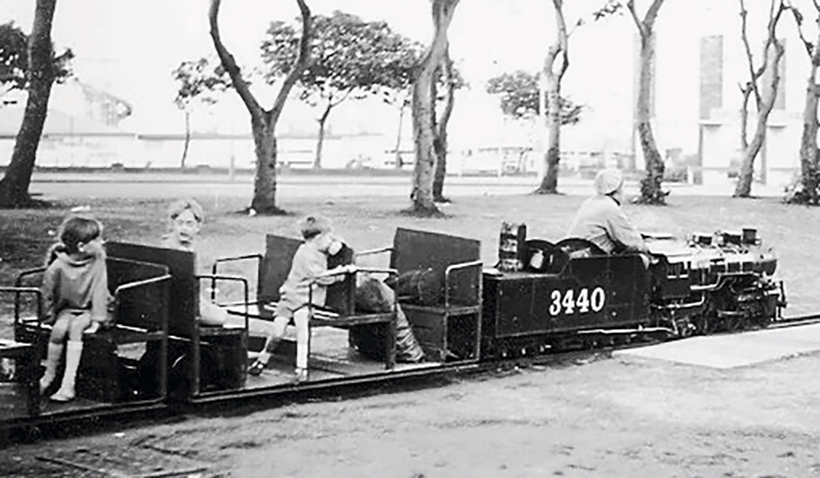
In 1972 there was no station building, but Mountaineer stands in the then station area in the opening year of operation. (Pic: Lakeshore Railroad)
Salvation was at hand, though, with Austerity being bought by a consortium which was trying to re-open the Lynton, Barnstaple Railway at Chelfham Viaduct, as a 9½in gauge line. Unfortunately, at the time the scheme failed to materialise, so Austerity was sold and eventually bought by William Jennings, who soon began rebuilding the locomotive into a 2-6-2 plus tender, but the project was never completed due to his ill-health.
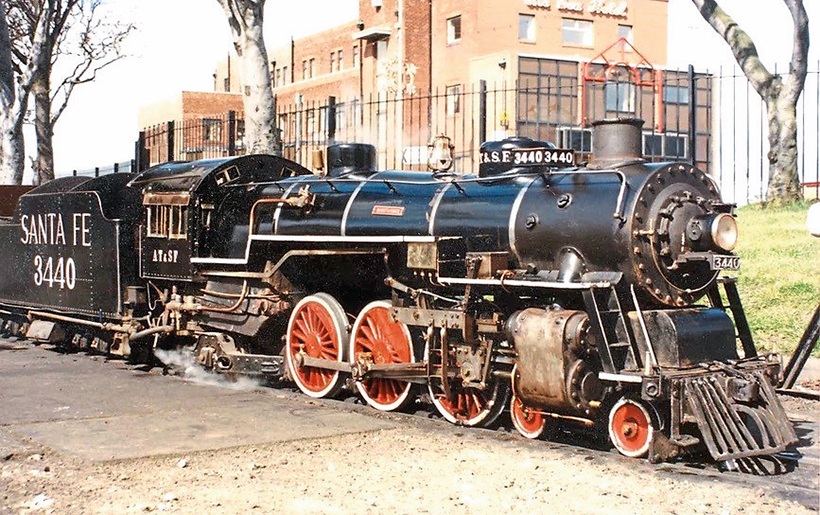
A very clean Mountaineer is seen at Lakeshore, possibly in 1977, after being converted to a Pacific 4-6-2 wheel arrangement.
(Pic: Lakeshore Railroad)
So, in the early 1970s, Don and Mike bought the part rebuilt chassis of Austerity as what was described as ‘a box of bits’, and rebuilt the locomotive between 1975 and 1976. Now named Adiela, this 2-6-2 Tender FCNDelM Prairie locomotive No. 27 joined Atlantic locomotive Mountaineer in August 1976.
The loco then ran regularly up until 2010 when it required boiler repairs, with its chassis also receiving a heavy overhaul with various parts being replaced. Adiela returned to service in time for the 2014 summer season, and has performed admirably ever since.
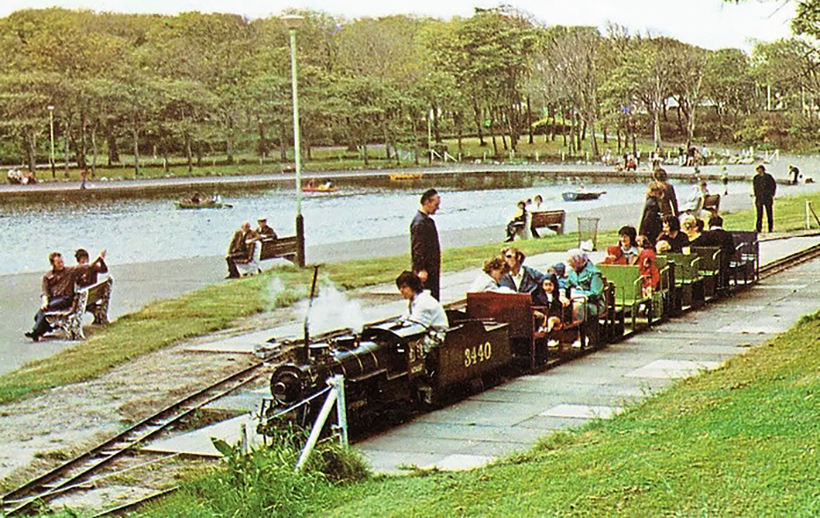
Work is in progress on the new loop in the station area in 1975, which allowed two trains to operate on the line. (Pic: Lakeshore Railroad)
With two engines in operation, track was laid into a second shed, and with the completion of a station passing loop, two-train operation was now possible. The acquisition of Adiela also allowed the 4-4-2 Atlantic Mountaineer to be converted to a 4-6-2 Pacific, with extra wheels being cast, and the frames cut and lengthened by 14½ inches, with other parts for the conversion being fabricated and fitted. The loco appeared in its new guise for the first time at Easter 1977, although some of the curves on the track needed to be adjusted for the longer Mountaineer to negotiate them.
In the late 1980s, most of the track was re-laid with new materials, and the track complex at the engine sheds was completely altered, eliminating the need for a turntable. Thoughts also turned to the station area, where an open canopy was constructed with semaphore signals and a water tower helping to set the scene.

Mountaineer is seen having a wheel drop in 1980. (Pic: Lakeshore Railroad)
There was also a change of personnel too, with Mike Henderson eventually becoming the sole owner in 2008, while a number of non-coaching vehicles were acquired, mainly for engineering and maintenance use. This coincided with the building of the Lakeshore’s first internal combustion loco, namely a four-wheel petrol hydraulic in the style of a Lister AutoTruck. Named Rockclimber, the idea was for it to be used for instant-start maintenance and shunting purposes, although it does take its turn on occasional passenger services to cover mechanical failure, and on some low-season days. New rolling stock was also constructed which required extra storage, with the track in the shed area receiving further attention.
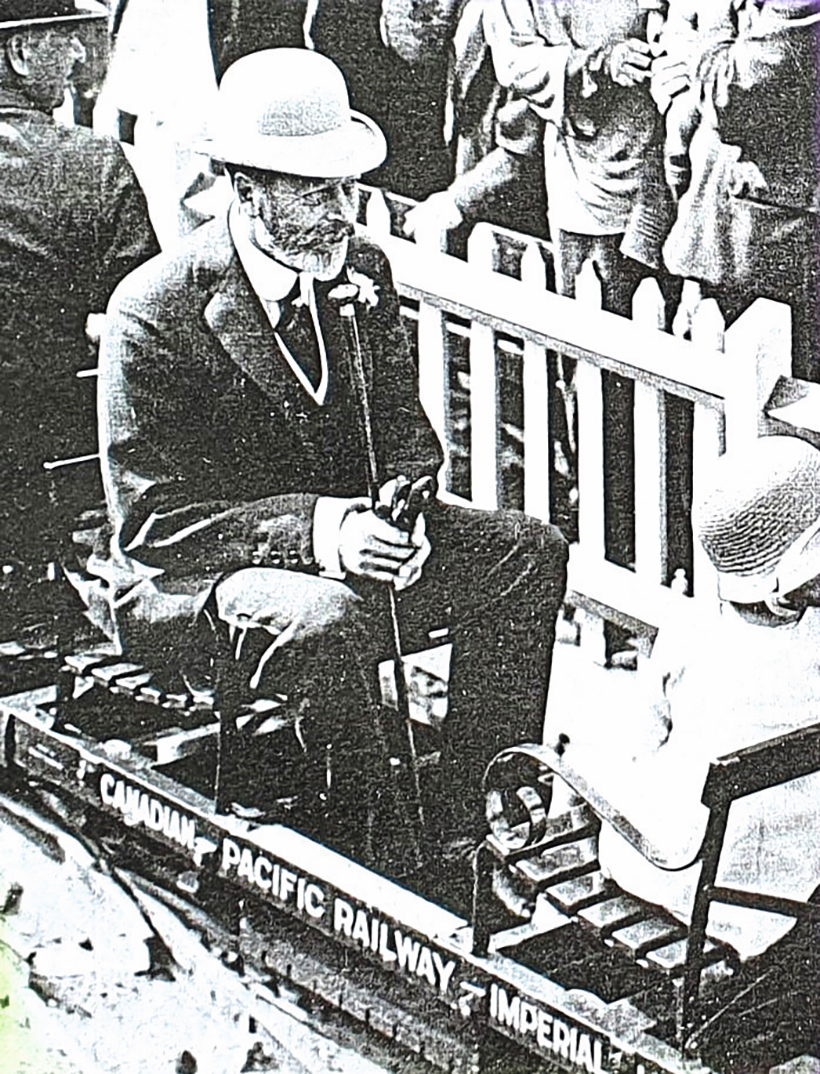
King George V seen on one of the ‘Wembley’ coaches at the British Empire Exhibition that was held at Wembley in 1924. (Pic: Lakeshore Railroad)
But it was the railroad’s 50th anniversary that was the highlight of my visit, and marked the first time that Mountaineer and Auld Reekie have been side by side since their construction. Indeed, it was also the first time in living memory that two Jennings engines have met at all! Also a big draw were Martin Green’s two ‘Wembley’ coaches, which had been commissioned for the British Empire Exhibition at Wembley in 1924, with no less than King George V himself taking a ride in them. “They have been the most popular coaches all weekend,” said Matt Nunn, the Railroad’s events and marketing manager.
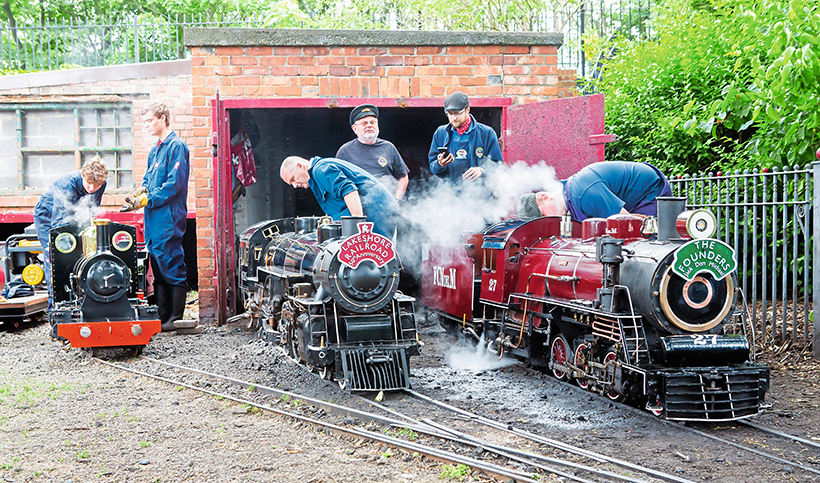
There was a lot of activity in the shed area as the staff of the Lakeshore Railroad got the locomotives ready for the day’s work.
There were other locomotives visiting Lakeshore Railroad too. The first was James Boyd, a 2-6-2 steam locomotive that was visiting from The Downs Light Railway. The engine had been built in 1991 by Milner Engineering, incorporating parts from the Down’s original 1910 Spriggs-built locomotive Tubby; a 2-6-2 tender locomotive that was built in 1924 using Parver/Bassett Lowke parts. Originally gauged at 7¼in, it went through a couple of modifications, being re-gauged in 1937 to 9½in with the engine having a long life before being eventually retired in 1989 and dismantled.
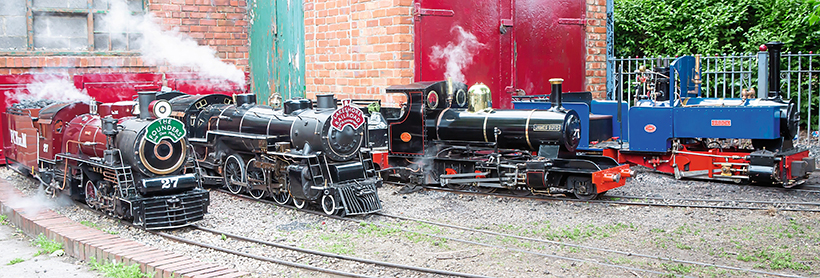
Mountaineer and Adiela from the Foreshore Railroad stand next to visiting locos from The Downs Light Railway, James Boyd and Brock.
The new locomotive was initially named Tubby II, but was officially named James Boyd after the respected railway historian, author and former pupil of the Downs Malvern, who was instrumental in the restoration and development of the railway from the 1970s onwards. The locomotive is often described as being the flagship of the Downs Light Railway, but is no stranger to the South Shields line either, visiting the railway in 2017 to help celebrate Lakeshore’s 45th anniversary weekend.
Another visitor to the Lakeshore Railroad was Brock, a 0-4-0 locomotive that also resides at the Downs Light Railway. It was built in 1973 by David Curwen, and bequeathed to the railway in 1995, while making the trip with Martin Green from the Crewe & Weston Miniature railway was Dave, another ‘Lister’ 0-4-0 petrol loco. “Martin’s wife saw Rockclimber at Lakeshore and in 2019 asked Martin to build one,” Matt said, “It was the first time that the two engines had met and they’re the only 9½in gauge Listers in existence.”
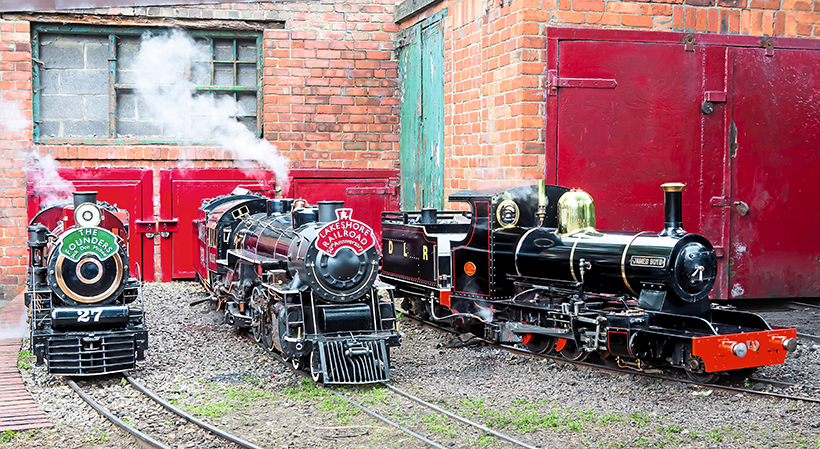
An early-morning line-up of Mountaineer and Adiela alongside visiting locomotive James Boyd stand on shed.
It was a great weekend, with many visitors making the trip to South Shields to enjoy the fun. Another highlight were the ‘Lakeshore or Bust’ specials that had all of the locomotives coupled together, pulling everything that could roll on one passenger train. It was a great sight to see.
Lakeshore Railroad’s events and marketing manager Matt Nunn was delighted with the success of the weekend. “It has gone really, really well,” he said. “We’ve had a good reception from the people of South Shields. The local community has really rallied round, and we’ve had lots of support.”
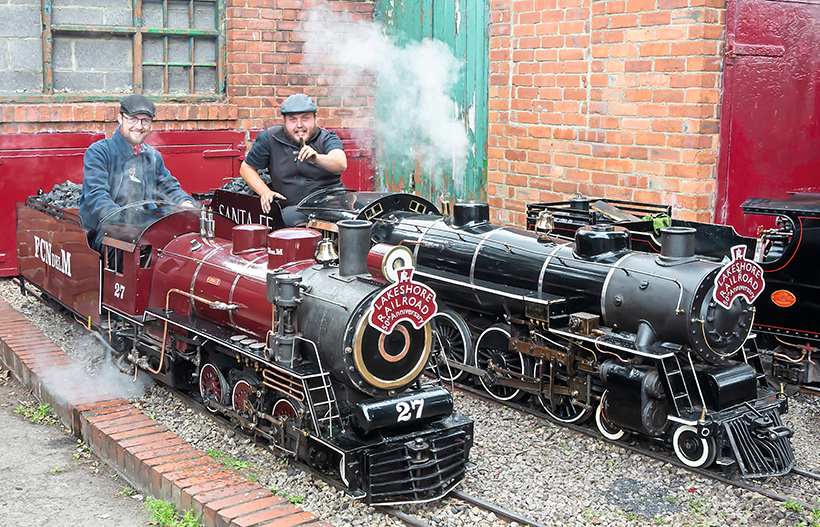
With respective drivers, the two resident locos Mountaineer and Adiela are just about ready to take to the track for the day’s work.
Matt was also grateful to Anthony Coulls, the senior curator of Rail Transport at the National Railway Museum, who cut the ceremonial ribbon during the weekend, and to John Kerr and Adam Jeffrey from Arbroath for travelling down from Scotland with Auld Reekie, the first time that the loco had been back in England since 1936. He also thanked Martin Green for bringing the ‘Wembley coaches’, and all at The Downs Light Railway from Worcestershire who had brought James Boyd to South Shields. “They have helped us so much over the weekend, it wouldn’t have been the same without them,” he added.
It was a great weekend all round, with good crowds taking the opportunity to take a ride around the third-of-a-mile circuit. The railway is well worth a visit, with more details available on the Lakeshore Railroad’s website, with other information and photographs of their locomotive’s maintenance available via the Facebook page.
This feature comes from the latest issue of Old Glory, and you can get a money-saving subscription to the magazine simply by clicking HERE





